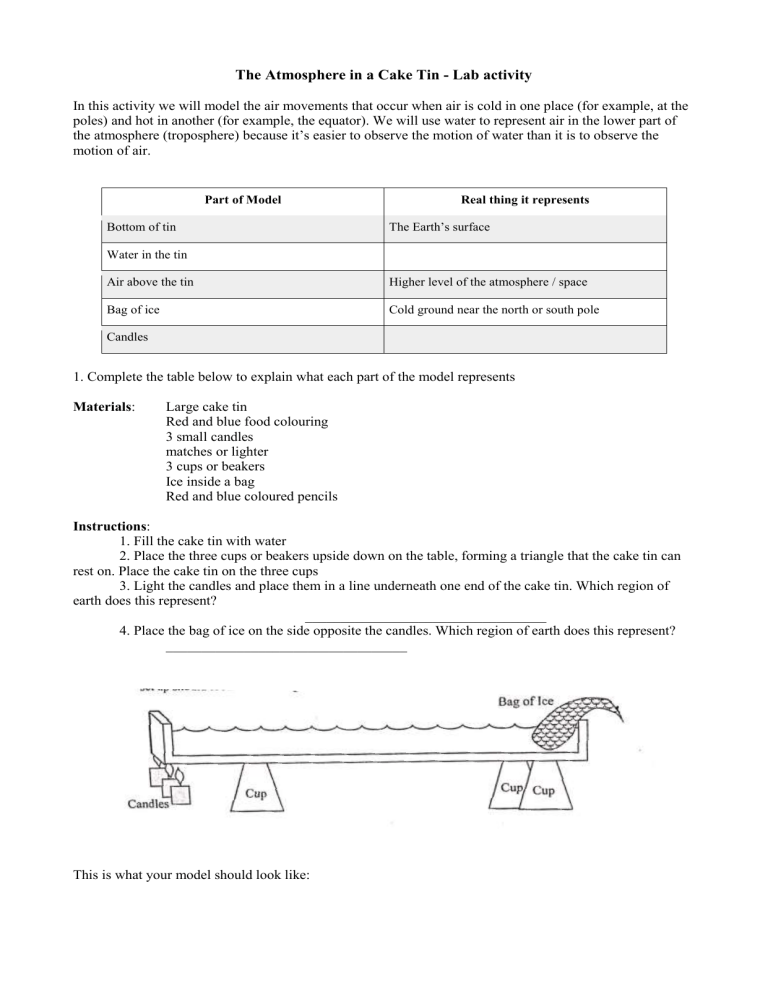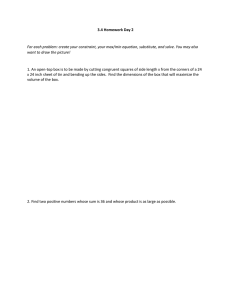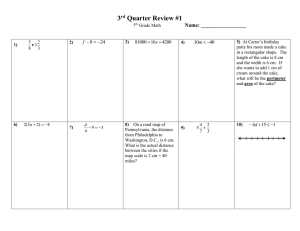
The Atmosphere in a Cake Tin - Lab activity In this activity we will model the air movements that occur when air is cold in one place (for example, at the poles) and hot in another (for example, the equator). We will use water to represent air in the lower part of the atmosphere (troposphere) because it’s easier to observe the motion of water than it is to observe the motion of air. Part of Model Bottom of tin Real thing it represents The Earth’s surface Water in the tin Air above the tin Higher level of the atmosphere / space Bag of ice Cold ground near the north or south pole Candles 1. Complete the table below to explain what each part of the model represents Materials: Large cake tin Red and blue food colouring 3 small candles matches or lighter 3 cups or beakers Ice inside a bag Red and blue coloured pencils Instructions: 1. Fill the cake tin with water 2. Place the three cups or beakers upside down on the table, forming a triangle that the cake tin can rest on. Place the cake tin on the three cups 3. Light the candles and place them in a line underneath one end of the cake tin. Which region of earth does this represent? __________________________________ 4. Place the bag of ice on the side opposite the candles. Which region of earth does this represent? __________________________________ This is what your model should look like: Questions: 1. On the diagram on the previous page, use arrows to show any (invisible) motion of the water that you think may be occurring due to temperature differences across the cake tin. 2. Explain why you think the water is moving this way. _______________________________________________________________________________________ _______________________________________________________________________________________ _______________________________________________________________________________________ Instructions continued: 5. After the cake tin has rested undisturbed for 5 minutes, place several drops of blue food colouring in a line along the bag of ice, near where it touches the water (see diagram below) 6. Carefully place several drops of red food colouring in a line along the BOTTOM of the cake pan directly above the candles (see diagram below) 7. Watch the motion of the coloured water and answer the following questions. Questions continued: 3. On the diagram below, use arrows and coloured pencils to show the motion of the red and blue water in the cake pan. 4. Did the motion you observed match your predictions? If note, explain why the motion that you did observe occurred. _______________________________________________________________________________________ _______________________________________________________________________________________ 5. What can we conclude about the density of the water near the candle as compared to the density of the water near the ice? Where is the water more dense? Why? _______________________________________________________________________________________ _______________________________________________________________________________________ 6. Are there any inaccuracies in your model? Describe them and suggest how they could be overcome. _______________________________________________________________________________________ _______________________________________________________________________________________ _______________________________________________________________________________________ 7. Which of the three types of heat transfer are occurring in your model? Explain where they are happening in the model.

